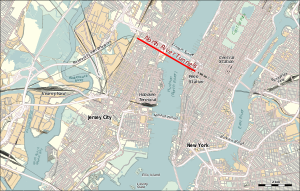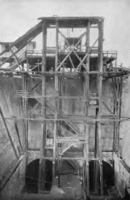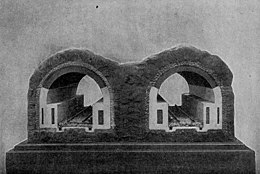North River Tunnels
| North River Tunnels | ||
|---|---|---|
|
Tunnel entrance in New Jersey
|
||
| use | Railway tunnel | |
| traffic connection | Northeast Corridor | |
| place |
North Bergen , New Jersey |
|
| length | 4442 m | |
| vehicles per day | 450 trains | |
| Number of tubes | 2 | |
| Largest coverage |
Bergen Hill Tunnel: 60 m. North River Tunnel: 18 m |
|
| construction | ||
| Client | Pennsylvania Railroad | |
| building-costs |
entire New York Tunnel Extension : 100 million dollars |
|
| start of building | 1904 | |
| completion | 1910 | |
| planner | Charles M. Jacobs | |
| business | ||
| operator | Amtrak | |
| map | ||

|
||
| location | ||
|
|
||
| Coordinates | ||
| Bergen Hill Portal | 40 ° 46 '17 " N , 74 ° 2' 31" W. | |
| New York Pennsylvania Station | 40 ° 44 ′ 59 ″ N , 73 ° 59 ′ 30 ″ W. | |
The North River Tunnels , often referred to simply as the North River Tunnel , is a railway tunnel opened in 1910 , which runs from New Jersey under the Hudson River to New York Pennsylvania Station (Penn Station) in Manhattan and is part of the Northeast Corridor . The 1810 m long land tunnel under Bergen Hill is also called the Bergen Hill Tunnel , and the 2004 m long underwater tunnel is the actual North River Tunnel. The two structures are usually collectively referred to as the North River Tunnels . North River is a name previously used for the Hudson for the section of the river that runs along Manhattan.
meaning
The North River Tunnels were used by around 450 Amtrak and NJT trains each day in 2018, each carrying 820,000 commuters. The New York Pennsylvania Station is one of the most important gateways of Manhattan for commuters in the state of New Jersey to live. As part of the Northeast Corridor, the tunnel's significance extends beyond New York and New Jersey. The Northeast Corridor is one of the busiest passenger rail routes in the United States , stretching from Boston to Washington, DC . Approximately a quarter of the 820,000 daily passengers on the Northeast Corridor travel through the North River Tunnels. The tunnel thus plays an important role in the Northeast American economic region, which contributes $ 3 billion to the US economy every year.
history
In the early days of railroad history, the Pennsylvania Railroad (PRR) had no direct access to Manhattan. The main route from Philadelphia to New York City ended in Jersey City at Exchange Place Station on the west bank of the Hudson River. The travelers had to take a ferry across to Manhattan. Several projects tried to create a direct connection for the PRR to Manhattan. Construction of a tunnel to Christopher Street has already started, but the project had to be abandoned due to lack of funds. Another project tried to build a suspension bridge over the Hudson. The bridge to be built by the North River Bridge Company could have been used by all railways ending on the west coast of the river, but no railroad company except the PRR wanted to contribute to the costs.
At the end of the 19th century, electric traction reached a maturity that made it possible to electrify mainline railways , even if the projects were still modest. The electric locomotives were able to overcome steeper gradients more easily than the steam locomotives and the tunnels remained smoke-free, so the effort for tunnel ventilation could be kept low. After the Baltimore and Ohio Railroad good experience with the electrical equipment in the Howard Street tunnel in Baltimore made and Alexander Cassatt , the then President of the PRR, the 1900 to the World Fair in Paris reopened Gare d'Orsay the PO in Paris had visited, the PRR worked out a project for a new magnificent train station in Manhattan, which was to be reached with underground access.
The planning of the project called New York Tunnel Extension began in 1901. The centerpiece was the new Pennsylvania Station to be built, which is usually just called Penn Station. The North River Tunnels are the western approach to the new train station, the East River Tunnels the eastern connection to Long Island . The new line to be built leads from Newark in New Jersey over the alluvial plain of the Hackensack River to the North River Tunnels. These lead the train under the cliffs along the west bank of the Hudson River and under the river to Manhattan to Penn Station. From there the East River Tunnels lead under the river of the same name to the Sunnyside Yard in Queens .
The estimated costs for the entire New York Tunnel Extension between Harrison and Sunnyside Yard including the Pen Station were estimated at 100 million US dollars , the actual costs were 150 million US dollars, which translates into purchasing power of 4 billion US dollars in 2020 corresponded.
The New York Tunnel Extension opened on November 27, 1910. The long-distance trains hauled by steam locomotives from the south ran to the Manhattan Transfer Station , where the steam locomotive was exchanged for an electric locomotive of the DD1 series , which took the train through the North River Tunnels to Penn Station. A third rail with a direct voltage of 650 V was used to power the electric locomotives. From 1933 the trains from Philadelphia ran continuously electrically, with an overhead line with 11 kV 25 Hz alternating current for the energy supply. The stop in Manhattan was only for the transfer to the trains of the Hudson and Manhattan Railroad (H&M), today's PATH , which created a direct connection to the southern tip of Manhattan. From 1937, the H&M trains ran to Newark, so the Manhattan Transfer Station was no longer needed.
In 1967 the PRR merged with New York Central to form Penn Central . This company went bankrupt in 1970. The route and long-distance traffic was taken over on May 1, 1971 by the newly founded semi-state long-distance operator Amtrak , and local traffic was transferred to New Jersey Transit (NJT) in 1976 .
ARC tunnel
With the Access to the Region's Core project , mostly just called the ARC tunnel , two new tunnels were to be built under the Hudson, which would have ended in a six-track underground station next to the Pennstation. The detailed planning began in 1995, construction began in June 2008. The project but was stopped in October 2010 because Chris Christie , the governor of New Jersey , cost overruns of up to one billion dollars feared.
Hurricane Sandy
The tunnels were flooded with salt water in October 2012 during Hurricane Sandy , which entered the tunnels mainly from the Manhattan side. In the middle of the tunnels the water level reached over the shoulder. After the water was pumped out, corrosive chlorides and sulphides remained, which damaged the concrete lining, the verges and the electrical installations in them - a process that continues for years after the flooding. Again and again, chipped concrete parts lying on the tracks lead to operational disruptions, in winter icicles that form due to penetrating water have to be removed regularly . There are also more frequent failures of the high-voltage cables , which not only supply the traction current for the railroad, but also supply the entire Penn station complex with energy.
Gateway Program
The Gateway Program was intended to expand the existing route between Newark and Manhattan, for which purpose a new tunnel should have been built under the Hudson. The project was unveiled in 2011 but was blocked under the Trump presidency. Amrak therefore decided in February 2020 to renovate the existing North River Tunnels. It is assumed that each tube must be closed for at least 18 months for the work and that 75% of the trains will fail during this time. During the closure, the gravel superstructure that will still be in place in 2020 is to be replaced by a slab track .
construction
The planning of the tunnels began in 1901. The management was held by Charles M. Jacobs , a British engineer who was already involved in the construction of the tunnel for the City and South London Railway (C & SLR). This train is considered to be the first deep underground underground in the world to be laid in a bored tunnel. The original North River Tunnels project included three tubes, but was later reduced to two tunnels. The contract to build the tunnels was awarded in May 1904 to the O'Rourke Construction Company , run by the son of an Irish immigrant. In June 1903, the construction of the two attack shafts in Weehawken and Manhattan was awarded to the United Engineering & Construction Company . The shaft in Weehawken was completed in September 1904, the one in Manhattan in December 1903. The two tunnels were driven with compressed air shields, with four 102 t heavy shields in use, so that work could be carried out in both tubes from both sides. During the advance, each shield was pressed against the tunnel face by 24 hydraulic cylinders with a force of 26700 kN . The shield drive began in May 1905 and in November 1906 the last ring of the tunnel tubes could be built.
23 m deep attack shaft at Weehawken
Building
The west tunnel portal is located in North Bergen immediately east of Tonnelle Avenue, which is part of US Hwy 1 and 9 . The portal is referred to as the Hackensack Portal or the Bergen Hill Portal . Bergen Hill, the southern foothills of the cliffs on the Hudson River called Palisades , is crossed under with a mined 1810 m long land tunnel, the Bergen Hill Tunnel. The tunnel leads through basalt and sandstone , the cover is 60 m. The tunnel runs with a gradient of 13 ‰ towards the Hudson River. At Weehawken on the west bank of the river is the ventilation shaft ⊙ which served as an attack shaft for the Bergen Hill Tunnel and the underwater tunnel during construction, the other attack shaft was in Manhattan between 10th and 11th Avenues .
The underwater tunnel is 2 km long between the two attack shafts. It consists of two tubes lying in the mud of the Hudson River, which slope down towards the middle of the river. The deepest point is 30 m below the water level of the river and is located near the west bank. From there the tunnel rises first with 5 ‰ towards Manhattan before it rises from a point near the east bank with 19.2 ‰ to Penn Station.
The outer shells of the tunnel tubes are formed from cast-iron tubbings that are screwed together and put together to form rings. Each ring is 2.5 feet (76 cm) wide and weighs 13.6 t, the outer diameter is seven meters. The inner lining of the tunnels is made of concrete and is 56 cm thick. In Manhattan, the tunnels cross under the West Side Yard of Penn Station and end on 10th Avenue in the station apron of Penn Station, which is located in a pit about 14 m below street level and is now completely covered.
Along the entire length of the tunnel there are high banquets on both sides, inside of which the power and signal cables run and the roof of which serves as a maintenance and emergency route through the tunnel. Every 90 m there are ladders that allow access to the track bed. There is an emergency exit in the ventilation shaft at Weehawken. The tunnel is equipped with a ballast superstructure. A conductor rail for Long Island Rail Road trains is also laid in both tubes , although they do not normally use the tunnel. With this, Amtrak created the possibility of evacuating broken Amtrak and New Jersey transit trains with the help of Long Island Railroad trains in the event of a contact line voltage failure. The western tunnel portal and the ventilation shaft in Weehawken are video-monitored. Flood gates have been installed at the western end of the underwater tunnel.
literature
- William Wirt Mills: The Pennsylvania Railroad Tunnels and Terminals in New York City . In: Moses King (Ed.): King's Booklets . New York 1904, OCLC 1050860090 .
Web links
Individual evidence
- ↑ a b c Christoph Sackmann: Why a 113 year old tunnel in New York endangers the US economy. In: Finances100 . March 6, 2018, accessed March 6, 2018 .
- ↑ a b Albert J. Churchill Ella: The Pennsylvania Railroad, Volume 1: Building an Empire, 1846-1917 . University of Pennsylvania Press, 2012, ISBN 978-0-8122-0762-0 , pp. 758 ff . ( google.cz [accessed March 1, 2020]).
- ↑ Hudson River vs. North River: which is right? In: Ephemeral New York. July 31, 2017, accessed March 2, 2020 .
- ↑ Patrick McGeehan, Christina Goldbaum: Expand Penn Station? Fight With Trump Stalls Tunnels to Get There . In: The New York Times . January 13, 2020, ISSN 0362-4331 ( nytimes.com [accessed February 29, 2020]).
- ↑ Chris Fry: Hudson River History: Hoboken's North River Bridge. In: Jersey Digs. March 8, 2017, Retrieved February 28, 2020 (American English).
- ^ A b Charles W. Raymond: The New York Tunnel Extension of the Pennsylvania Railroad . In: The Project Gutenberg. Retrieved February 24, 2020.
- ^ Gilbert H. Gilbert, Lucius I. Wightman, WL Saunders: The Subways and Tunnels of New York . John Wiley & Sons, New York 1912, p. 39 .
- ^ Davidson Gregg, Howard Alan, Jacobs Lonnie, Pintabona Robert, Zernich Brett: North American Tunneling: 2014 Proceedings . Society for Mining, Metallurgy, and Exploration, 2014, ISBN 978-0-87335-400-4 , pp. 139–150 ( google.cz [accessed February 29, 2020]).
- ↑ $ 100,000,000 in 1910 → 2020. In: Inflation Calculator. Retrieved March 3, 2020 .
- ^ Ted Sherman: NJ halts new work on $ 8.7B NY-NJ tunnel project due to budget issues. nj.com, April 10, 2019, accessed February 29, 2020 .
- ↑ HNTB (Ed.): Structural Assessment of the Amtrak Under River Tunnels in NYC Inundated by Super Storm Sandy . September 18, 2014, p. 2 ( tunneltalk.com [PDF]).
- ↑ a b Deteriorating Hudson River Tunnels. NBC New York, February 20, 2019, accessed February 27, 2020 .
- ^ Gateway Project dream results in heavy maintenance reality for North River Tunnels. February 27, 2020, Retrieved February 28, 2020 (American English).
- ↑ not to be confused with the British company Laing O'Rourke
- ↑ William Wirt Mills, p. 9
- ^ Davidson Gregg, Howard Alan, Jacobs Lonnie, Pintabona Robert, Zernich Brett: North American Tunneling: 2014 Proceedings . Society for Mining, Metallurgy, and Exploration, 2014, ISBN 978-0-87335-400-4 ( google.cz [accessed February 29, 2020]).
- ^ Joseph Shallit: New York Tunnel Extension Diagram. In: Wikimedia Commons. 1969-12-01, accessed February 29, 2020 .
- ^ The New York Tunnel Extension of the Pennsylvania Railroad. The North River Tunnels . In: Transactions of the American Society of Civil Engineers . tape LXVIII , no. 1155 . The Society, September 1910, pp. 236 ( wikimedia.org [accessed February 29, 2020]).
- ^ Opening of the Pennsylvania Terminal Station in New York . In: Scientific American . 103, No. 11, September 10, 1910, pp. 200-201. Retrieved February 29, 2020.
- ^ Pennsylvania Railroad (Ed.): Pennsylvania Railroad System's exhibit at the Alaska-Yukon-Pacific Exposition . Philadelphia 1909, p. 9 ( oclc.org ).
- ↑ Access to the Region's Core in Hudson County, New Jersey and New York County, New York: Environmental Impact Statement . 2008, p. 4.13-2 ( google.cz [accessed February 29, 2020]).











